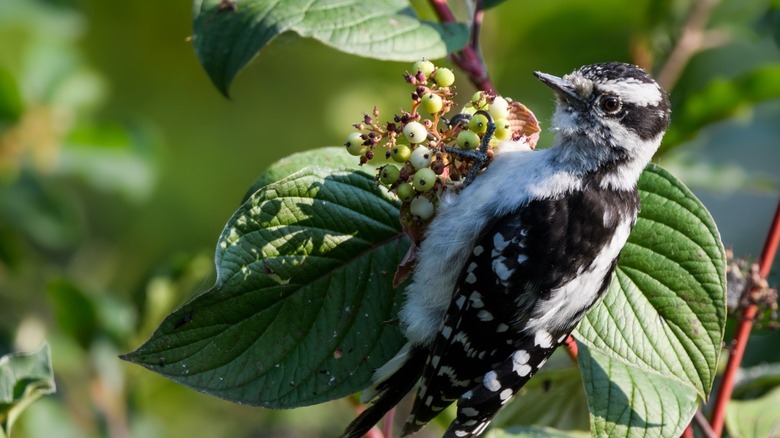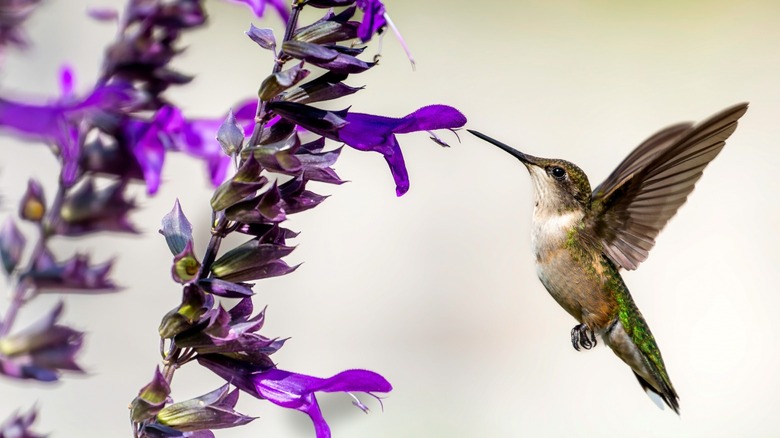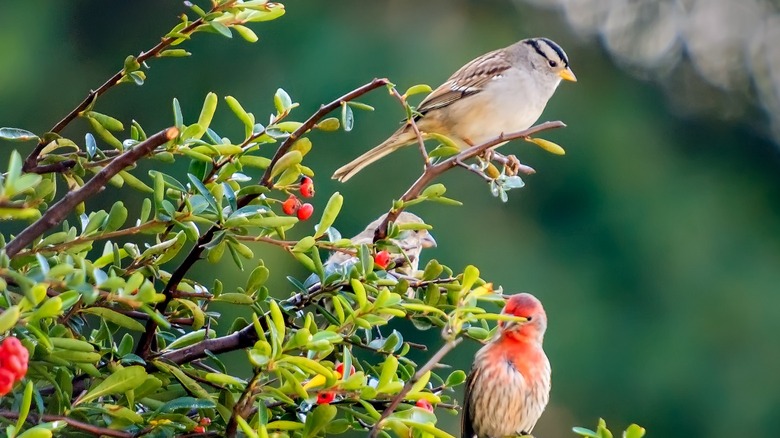Garden Trees, Shrubs & Vines
Rochelle Heath-Harris
Having the pleasure of experiencing the world of songbirds on our own little plot of land is about as close to heaven as we can hope to get while still on this planet. Like the white-picket-fence ideal, there are trees in the backyard and various features intentionally placed to attract birds, including suit blocks, bird feeders, and a small fountain — you get the picture. Whether this is currently still a dream or it’s become your reality, few people can say it doesn’t sound delightfully appealing.
Many people today are realizing how truly important it is for each one of us to do our part in being environmentally conscious. If you are a homeowner and have a plot of land with anything living on it, you will have a decision to make: Do you use chemicals, or not? More people are choosing the latter, which is a good thing for our birds, which we enjoy so much.
Something you might not be aware of, though, is how beneficial shrubs really are for birds and all the ways they support our feathered flying friends. If attracting birds is something that interests you, today we’re talking about all the different ways shrubs provide a safe haven — and so much more — for birds who frequent your little strip of paradise.
Shrubs provide a food source

FotoRequest/Shutterstock
There are a myriad of shrubs that provide a wonderful source of food for birds. For example, some dogwood varieties like gray and red-osier dogwoods, offer up fruitful berries in the fall, at a time when other seasonal fruits are becoming scarce. Songbirds that are migrating during that time depend on the high-fat content of these fruits. Because of this, it’s important to many varieties, including bluebirds, cardinals, robins, warblers, thrushes, grouse, wild turkeys, kingbirds, catbirds, juncos, and vireos.
Another terrific example is the staghorn sumac shrub, which also provides food in the fall and even into the winter, that feeds a variety of different birds. It’s striking in appearance with bright red foliage and spiky clusters of red fruit covered in hair, and birds love eating both the seeds and fruit of this shrub. Some of the birds that flock to the staghorn are bluebirds, cardinals, starlings, robins, pileated woodpeckers, wild turkeys, chickadees, thrushes, and catbirds.
Or how about planting a holly bush, also known as a “winterberry shrub”? These shrubs produce bright red berries in the fall that often last through the winter, and native birds especially depend on them. They also provide cover for birds when necessary and are tolerant of rainy conditions. You need to be sure you have a female plant if you want berries, and it helps to plant at least one male in a group of females. Bluebirds, robins, and waxwings are fond of this shrub.
Shrubs provide nectar for birds

Manu M Nair/Shutterstock
Some shrubs also provide much-needed nectar for birds and other pollinators. For example, the rose of Sharon is a variety of hibiscus and is considered a shrub, producing beautiful flowers that hummingbirds love to drink nectar from. Another great nectar-producer is the lilac bush, which has a bonus of smelling heavenly. This shrub produces nectar for hummingbirds and others early in the season, when they really need it due to food being scarce. Both of these shrubs add beauty and fragrance to your landscape, while simultaneously attracting birds and pollinators.
Another nectar-producing shrub is the weigela, with blooms shaped like trumpets for hummingbirds’ long beaks. The flowers that bloom are shades of magenta and fuschia in color and the foliage is burgundy, so it makes a lovely and bright addition to your landscape. These shrubs and the nectar they offer with their gorgeous flowers help to support birds, pollinators, and other wildlife. They’ll be visiting your yard in no time, after planting!
Shrubs provide shelter and nesting for birds

Lux Blue/Shutterstock
Shrubs also provide shelter and nesting sites for birds, especially if you don’t have any cats around to give them cause for concern. One of the best shrubs you can plant for nesting birds is pyracantha, also called “firethorns,” for their fiery red berries The shrub has the right structure, as well as the built-in food source, making it perfectly hospitable for nesting. It also displays delicate white flowers prior to sprouting berries, which happen to be a favorite of birds like sparrows, finches, and starlings. It is evergreen, making it a terrific source of food and shelter for them, even during the cold months.
When planting shrubs to attract birds for nesting, there are a few things to consider. Planting them in groups of three for optimal shelter and protection is one thing you can do to give them the best chances. Additionally, thorny bushes are better for birds to build nests in, because they provide some protection against predators. Keep in mind that shrubs also offer protection and shelter for birds during storms, even though they might not always build a nest in them. Shrubs are an important part of our ecosystem and help provide food, shelter, and generally a safe haven for the birds who visit us.



